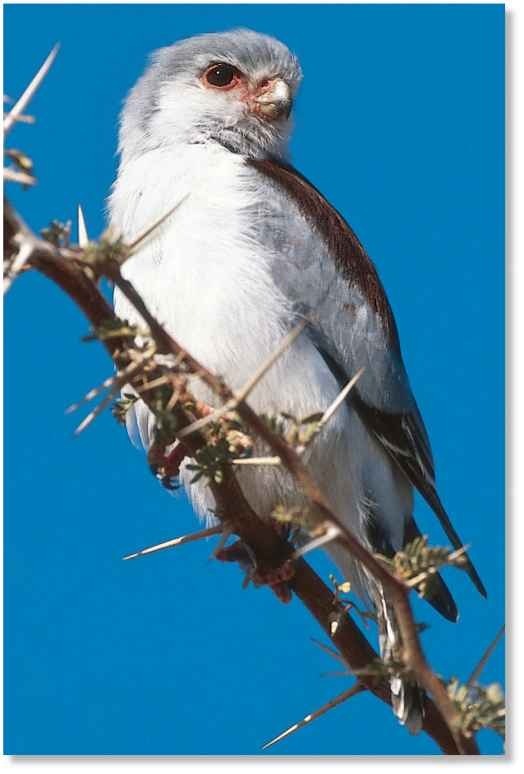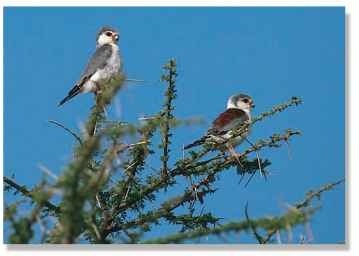ORDER
Falconiformes
FAMILY
Falconidae
GENUS & SPECIES
KEY FEATURES
• Uses the nests of birds called weavers to roost and breed
• Rapid and agile in flight, it darts through the air with short, quick bursts of speed
• Female easily distinguished from the male by her deep chestnut back
• Small raptor with powerful talons and a hooked beak for hunting prey
WHERE IN THE WORLD?
Found exclusively in eastern and southern Africa: parts of Ethiopia, Somalia, Uganda, [Kenya, Tanzania, Angola, Transvaal, Botswana, Namibia and South Africa
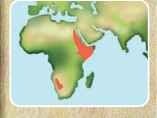
Lifecycle
Unlike other birds of prey that build a large solitary nest, the African pygmy falcon lives alongside a friendly host, the sociable weaver, and adopts a chamber in the weaver nest.
HABITAT
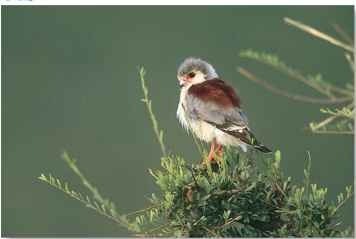
A Treetop
A female falcon perches at the top of a tall tree.
The African pygmy falcon lives in two distinct and widely separated populations in Africa: one in the southwestern part of the continent and the other in the northeast. In either part of the continent, the pygmy falcon inhabits the arid and semiarid savannah and scrubland, which features sparse groundcover and scattered large trees dotting the landscape. The African pygmy falcon typically avoids open forests and forest edges.This falcon also frequents the huge nests of weavers, especially the sociable weaver, Philetairus socius, sharing its roosting and nesting site. The pygmy falcon occasionally shares the nests of the white-headed buffalo weaver and those of the sparrow weaver.
Unlike other falcons, the eggs of the pygmy falcon are pure white, consistent with many birds that lay eggs in concealed nests.
The pygmy falcon’s range is dictated by that of the sociable weaver; it even avoids otherwise suitable savannah habitat that is devoid of weaver nests.
In the Kalahari region of Africa, pygmy falcons occupy about one out of every four sociable weaver colonies.
BREEDING
UNWANTED HOUSEGUEST
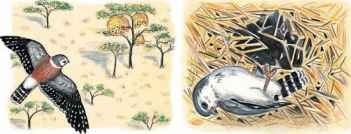
1 Flying
A female pygmy falcon flies toward a large nest colony of sociable weavers that the falcon exploits for its own use.
2 Hanging.
The entrance is located at the bottom of the nest colony; the falcon hangs upside down in order to enter the nest chamber.
FOOD & HUNTING
The African pygmy falcon mostly feeds on insects and lizards, though occasionally rodents and small birds are consumed. In spite of its small size, the African pygmy falcon is a voracious predator, like birds of prey. Perching from a tall tree, the pygmy falcon watches the ground below for movement from a potential meal.Once its victim is sighted, the pygmy falcon quickly dives to the ground, snatching its victim in its talons, and taking it back to the perch to be eaten.Like all falcons, the African pygmyfal-con regurgitates 1-2 pellets daily which contain all the indigestible food fragments, such as fur and bones.
► Tasty meal A male African pygmy falcon feasts upon a large lizard in the savannah.
Courtship begins in the summer and includes the male feeding his mate. The female performs exaggerated tail-wagging displays. No nest is built; instead the pair moves into a chamber in the nest colony of sociable weavers, which is comprised of a huge haystack structure built into a tree and contains chambers of up to 50 active weaver nests. Each chamber is enclosed and is reached from below through a narrow vertical tunnel.The falcon pair evicts 1-2 pairs of weavers from their nests, then the female lays from 2-4 eggs. While both parents incubate for about 30 days, the female’s share of the task is largerThe male provides his mate, and later the chicks, with food.The chicks are helpless at birth, but fledge in 28-30 days. They remain with their parents for 1-2 months after fledging before becoming completely independent.
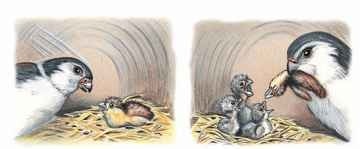
3 Striking.
The pygmy falcon strikes and kills a sociable weaver chick; this is uncommon, but necessary, when food is scarce.
4 Feeding
The pygmy falcon brings the dead weaver chick back to its nest chamber to feed it to its own young, hungry family.
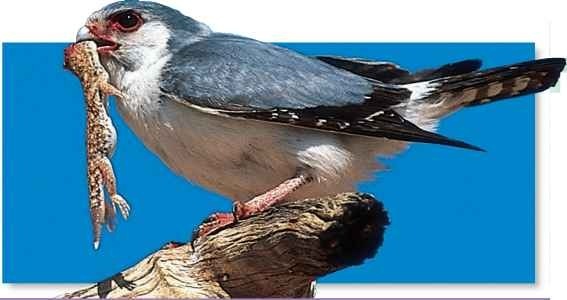
BEHAVIOR
African pygmy falcons are diurnal, with activity peaks in the early morning and late afternoon. They usually roost during the hotter parts of the day. These falcons are rapid and agile in flight, darting through the air in quick bursts, similar to those of a woodpecker Because of their small size, African pygmy falcons are able to share the nest colony of sociable weavers. These huge nests provide a safe, weatherproof environment for the falcons. The falcons do not bother the weavers beyond the eviction of 1-2 pairs and occasionally killing a chick when other food is scarce. While the falcon pairs enjoy the benefits of the weavers’ work, the weavers gain a pair of bodyguards to protect them from snakes, such as cobras, that prey upon the nest chambers. The sociable weavers happily continue to add and maintain the nest in spite of having an uninvited roommate.
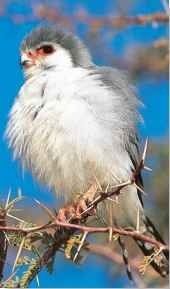
A Morning chill
To keep warm when chilly,the falcon fluffs its feathers.
CONSERVATION
The African pygmy falcon is a fairly common resident throughout its range and is not currently endangered. It is listed in Appendix II of CITES (Convention in International Trade in Endangered Species), which regulates the import and export of animals for the pet trade. Since its range is dependent upon weavers for nesting, the pygmy falcon has a very limited distribution. Due to its small size, it falls victim to predators, including larger birds of prey found in the same habitat.
PROFILE
African Pygmy Falcon
Despite its small size, the pygmy falcon is a bold predator armed with sharp talons and a strong, hooked beak for catching and killing its prey.
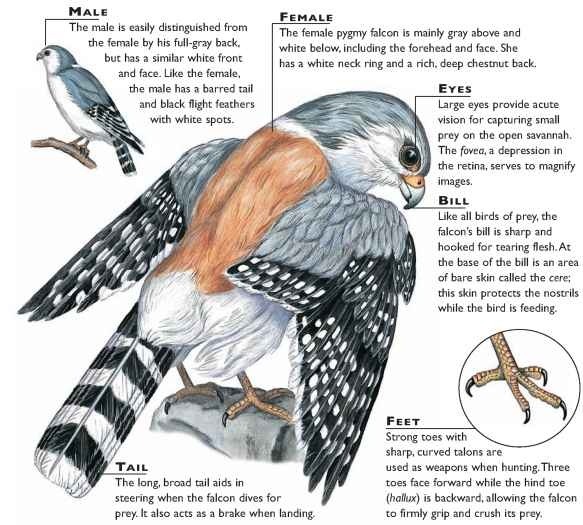
CREATURE COMPARISONS
Reaching 7” long, the collared falconet (Microhierax caerulescens) is slightly smaller than the African pygmy falcon and is one of the smallest of the raptors.The collared falconet has a glossy black back with white on its forehead, collar and sides of face; it has a chestnut chin and belly, compared to the pygmy falcon, which is mostly gray above and white underneath. Unlike the African pygmy falcon, which nhabits the semiarid and arid savannah, the collared falconet is mainly found at the edge of temperate forests. Despite their small size, both birds are bold predators, like their larger relatives.
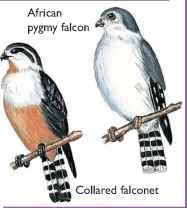
VITAL STATISTICS
Weight 2-3.5 oz.
Length 7-8”
Wingspan 12-14.5”
Sexual Unknown Maturity
Breeding Summer Season
Number 2-4;
of Eggs usually 3
Incubation 28-30 days Period
Fledging 27-40 days Period
Breeding 1 year Interval
Typical Mostly insects
Diet and lizards;
also rodents
I and small birds
Lifespan Unknown
RELATED SPECIES
• The African pygmy falcon is 1 of 2 species in the genus Polihierax; the other is the white-rumped falcon, P. insignis. The family Falconidae contains 64 species in 10 genera of falcons, falconets, kestrels, caracaras and hobbies. Close relatives of the African pygmy falcon include the crested caracara, Caracara plancus, the peregrine falcon, Falco peregrinus, and the brown falcon, F. berigora.
